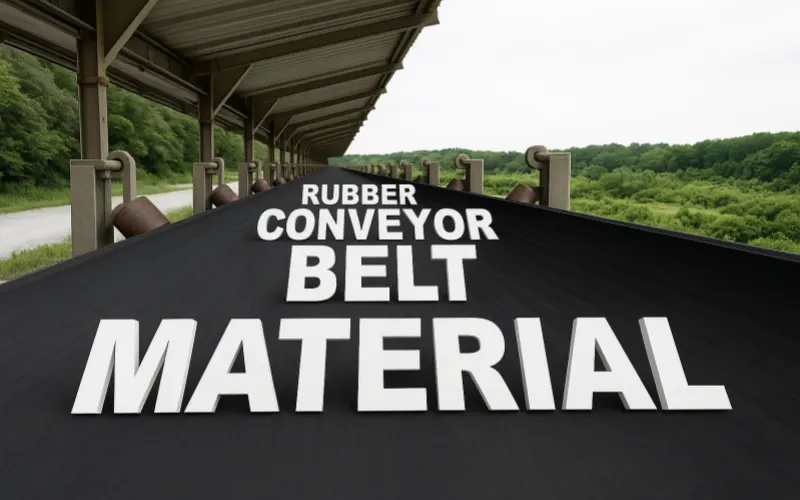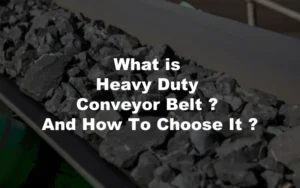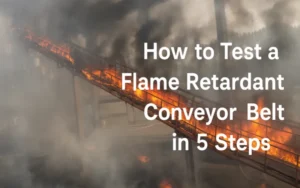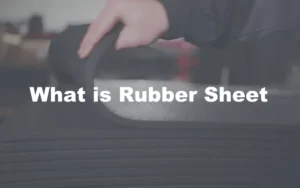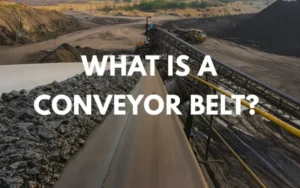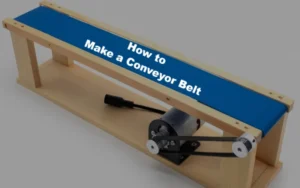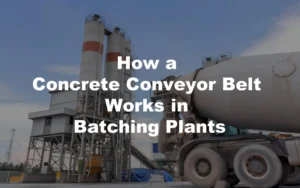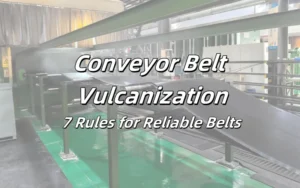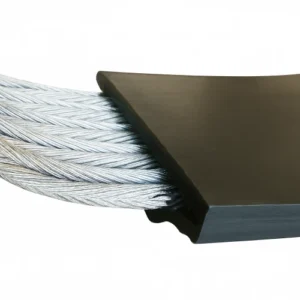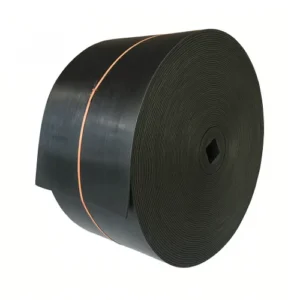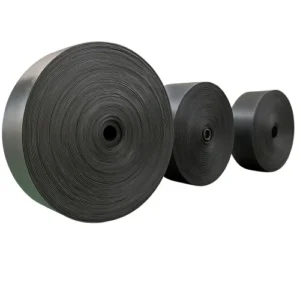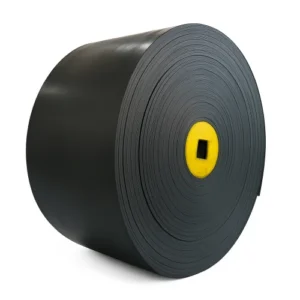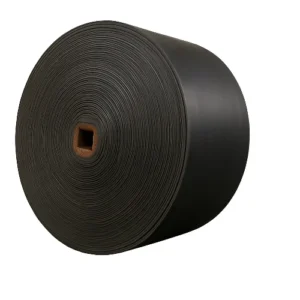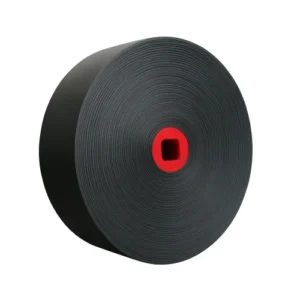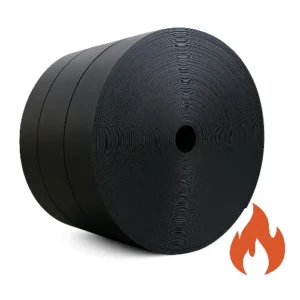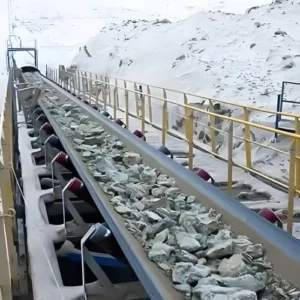The reliability of a conveyor belt truly begins at the cover, because that’s where the toughest challenges occur. Made from carefully engineered rubber conveyor belt material, the cover must endure heat in kilns, cold in Arctic ports, sharp abrasion in quarries, and chemical or oil exposure in plants. Backed by ISO and DIN standards, and proven in Tiantie’s belts for cement, steel, and fertilizer industries, this guide explains how the right compound cuts downtime, extends belt life, and ensures safe, efficient conveying.
1.The Importance of Rubber Conveyor Belt Material
As a technician working in a conveyor belt factory, I often explain that a conveyor system is like a chain — every link matters. The motor provides the drive, the pulleys ensure direction, and the belt delivers the load. If any part fails, the whole system is in trouble. But when we look specifically at the belt itself, it is built from several layers: the carcass for tensile strength, the bonding layer for stability, and the cover for protection. Among these, the cover made of rubber conveyor belt material is what faces the toughest challenges day after day.
The cover is in constant contact with the material, which means it has to resist high heat in a cement plant, stay flexible in frozen ports, fight abrasion in quarries, or handle oil in grain terminals. When the cover fails, cracks, or hardens, the entire belt quickly loses its function. That’s why the choice of Conveyor belt Rubber material is critical. Over the years, I’ve seen how EPDM excels in resisting heat, natural rubber stays elastic in extreme cold, and NBR protects against oil and fats. Each compound has its own role, and no single formula can do it all.
The real challenge, and also the art of my job, is to match the cover compound with the environment. This isn’t about adding complexity for its own sake, but about ensuring the belt delivers consistent performance, longer service life, and fewer breakdowns. Get the material right, and you don’t just build a belt — you build reliability into the entire conveyor system.
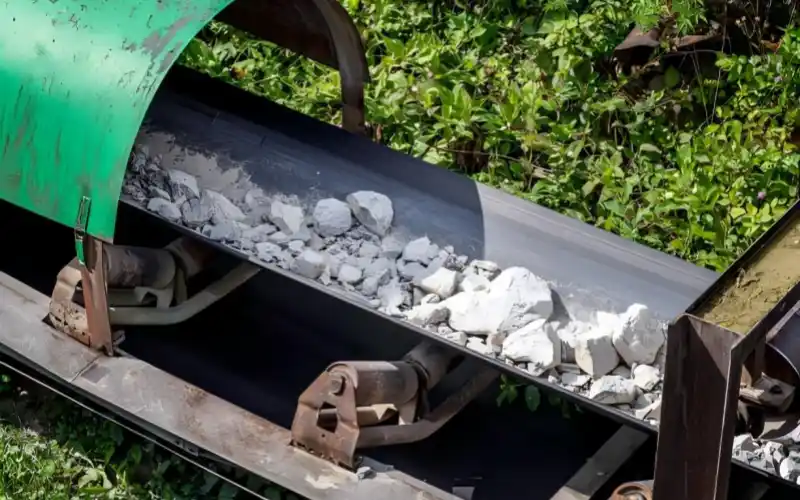
2.Heat-Resistant Rubber Conveyor Belt Material (T1–T4 and Beyond)
In high-temperature lines—cement kilns, coke ovens, sinter plants—the belt cover faces the most extreme stress. The carcass provides tensile strength, but it is the rubber conveyor belt material on the surface that determines service life. Getting this wrong leads to early hardening, cracks, and delamination. Getting it right means reliable production shift after shift.
2.1 Standards and Classifications
- ISO 4195: Divides belts into Class 1 (100 °C), Class 2 (125 °C), and Class 3 (150 °C) by aging performance.
- IS 1891-2 (India): Defines HR (≈T1), SHR (≈T2), and UHR (≈T3–T4).
- Engineering practice:
- T1≈ continuous ≤100 °C, peaks ≤150 °C
- T2≈ continuous ≤125 °C, peaks ≤170–200 °C
- T3≈ continuous ≤150 °C, peaks ≤200 °C
- T4 (standard): continuous ≤200 °C, peaks ≤250–300 °C
- Beyond T4 (unofficial extension): in controlled cases, specially formulated EPDM compounds withstand short peaks up to 400 °C, but this is outside ISO definitions and must be specified case by case.
2.2 Polymer Systems and Formulations
Grade | Engineering Range* | Polymer System (phr) | Curing & Additives (phr) | Carbon Black (phr) | Applications |
T1 (HR) | ≤100 °C cont.; ≤150 °C peak | NR 20–40 + SBR 60–80 | Sulfur 1.3–1.8; CBS/TBBS 0.6–1.0; TMTD 0–0.3; TMQ 1.5–2.5; Paraffin 1–2; PVI 0.1–0.2 | 40–60 (N550/N650) | Light cement, general heat duty |
T2 (SHR) | ≤125 °C cont.; ≤170–200 °C peak | EPDM 30–60 + SBR 40–70 | Option A: Peroxide (DCP 1.5–2.5 + TMPTMA 3–5); Option B: Sulfur ≤1.2 + accelerators; Antioxidants 1.5–2.5 | 40–55 (N550/N772) | Cement, building materials |
T3 (UHR) | ≤150 °C cont.; ≤200 °C peak | EPDM 70–100 | DCP 1.5–2.5 + Co-agent 3–7; Antioxidants + stabilizers | 30–50 (N772/N990) | Steel mills, foundries |
T4 (Standard) | ≤200 °C cont.; ≤250–300 °C peak | EPDM 100 | Strong peroxide + co-agent; Heat stabilizers + metal soaps; low oil 5–12 | 30–45 (N772/N990, some white fillers) | Clinker lines, coke ovens |
Beyond T4 (unofficial) | 200 °C+ cont.; ≤400 °C peaks (controlled) | EPDM 100 (special grade) | High-dosage peroxide + multifunctional co-agent; advanced heat stabilizers | 30–45 (N772/N990, partial silica/white fillers) | Rare, niche extreme-heat service |
* Engineering ranges = material temperatures. ISO 4195 test temperatures differ.
2.3 Tiantie Industrial’s Product Integration
According to Tiantie’s catalog, our Heat Resistant Conveyor Belts are manufactured with special rubberized fabrics and optimized ST steel cord reinforcement. This ensures both strength and heat resistance. Key data:
- Average material temp: 100–180 °C
- Belt surface: 120–200 °C
- Peak material temp: 150–300 °C, with some controlled cases handling up to 400 °C incandescent peaks.
- Applications: metallurgy, cement, fertilizer.
These values align with T2–T4 classifications and confirm that our belts operate reliably where standard SBR belts would fail early.
2.4 Testing and Verification
Purpose | Method | Criteria |
Heat aging resistance | ISO 4195 oven aging (7 d) | ΔHardness, ΔTS, ΔEb ≤ limits of Class 1–3 |
Peak validation | Hot drop & belt loop tests | No cracks/delam at 200–300 °C |
Field performance | On-site trials in cement kilns | Service life ≥ planned cycle |
2.5 Structure, Process, and Failure Modes
- Synergy: Cover rubber alone is insufficient; bonding rubber and carcass must also be heat-stable.
- Process: Poor peroxide dispersion → blowholes; bad vulcanization → premature hardening.
- Failures: Surface cracking from thermal cycling; delamination if bonding layer degrades; shrinkage/blistering with volatile oils.
2.6 Lifetime Prediction & Maintenance
Parameter | Frequency | Action |
Hardness drift | Monthly | >+10 ShA per quarter → check chute cooling |
Crack density | Weekly | Increase in cracks → adjust drop height/cooling |
Splice inspection | Bi-weekly | Early peel → upgrade adhesive or cord coating |
Choosing the right rubber conveyor belt material means balancing official T1–T4 standards with real engineering demands. Tiantie’s heat resistant belts combine advanced EPDM formulations with special fabric and cord design, enabling reliable service at 200 °C continuous and, in rare controlled cases, short peaks up to 400 °C.
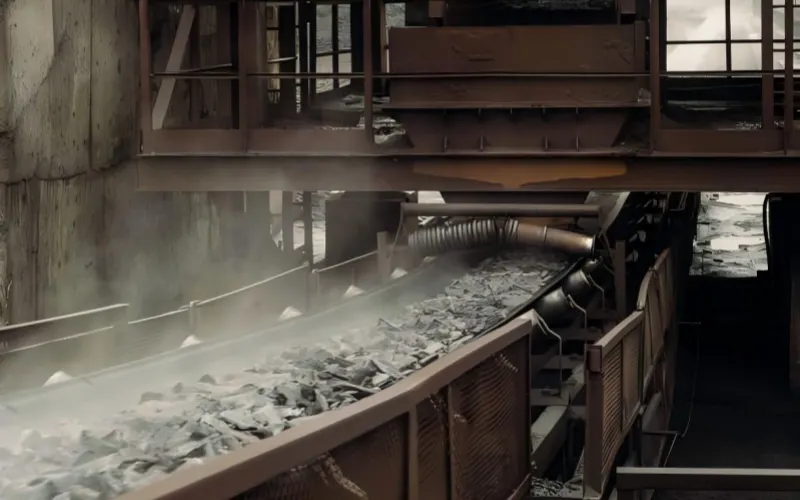
3.Cold-Resistant Rubber Conveyor Belt Material
In northern mines, ports in Russia, or open-pit operations in Canada, extreme cold is just as destructive as extreme heat. A belt that turns brittle in winter will crack on the first load impact. That’s why rubber conveyor belt material designed for low temperatures must remain flexible, elastic, and adhesive even at −40 °C or below.
3.1 Standards and Test Methods
- ISO 812 / ASTM D2137: low-temperature brittleness and impact tests.
- ASTM D746: brittle point determination.
- ISO 2921 (TR test): measures retraction temperature (TR10/TR70) to assess elasticity under cold.
- Engineering practice: belts are often rated by flexibility at service temperature, not just lab brittleness.
3.2 Cold Resistance Levels and Formulation Systems
Cold Class | Engineering Range | Polymer System (phr) | Curing & Additives (phr) | Carbon Black (phr) | Applications |
−20 °C grade | Flexibility to −20 °C | SBR 20–40 + BR 20–40 + NR 30–40 | Sulfur 1.2–1.6; TBBS/CBS 0.6–1.0; small TMTD; antioxidants | 35–50 (N550) | General outdoor use, mild winter |
−40 °C grade | Flexibility to −40 °C | BR 50–70 + NR 30–50 (small SBR optional) | Sulfur 1.0–1.4; TBBS/CBS 0.5–0.8; antioxidants + wax | 30–45 (N550/N660) | Arctic ports, mining, cold logistics |
−60 °C extreme | Flexibility to −60 °C | BR ≥70% + NR 20–30 | Sulfur 0.8–1.2; slow accelerators; antioxidants | 25–40 (N660/N990) | Special pipelines, polar regions |
Mechanism: BR lowers Tg (glass transition), NR keeps tear strength, while oils and waxes prevent crystallization.
3.3 Tiantie’s Cold-Resistant Belts
Our catalog specifies Cold Resistant Conveyor Belts that remain flexible down to −50 °C. This performance is achieved through a high-BR compound system blended with NR, plus special plasticizers that reduce Tg and keep the cover from cracking.
- Applications: ports, open-pit mines, and northern logistics hubs.
- Structure: reinforced carcass with low-temperature adhesive layers ensures the belt does not delaminate during repeated flexing.
3.4 Testing and Verification
Purpose | Method | Criteria |
Brittleness | ISO 812 / ASTM D2137 | No fracture at target cold rating |
Elastic recovery | ISO 2921 TR test | TR10 ≤ −40 °C for −40 grade |
Field trials | Arctic conveyor loop | Flexibility and splice integrity over winter |
3.5 Failure Mechanisms and Process Notes
- Brittleness / cracking: too high Tg → solved with BR-rich system.
- Edge delamination: poor low-temp adhesion → solved with compatible cold adhesives.
- Oil migration: excess softener → causes surface bloom, handled by low-volatility oils.
3.6 Lifetime and Maintenance
Cold belts last longest when:
- Stored indoors before installation.
- Avoided from sudden bending below design temp.
- Regularly inspected for microcracks at pulleys and splices.
In freezing mines and ports, the real difference is not seen in the lab but on the belt line. Tiantie’s cold-resistant belts, engineered to perform down to −50 °C, keep running when conventional belts turn brittle and crack. By combining BR-rich polymers with NR and low-volatility oils, we deliver the flexibility and splice integrity that harsh winters demand.
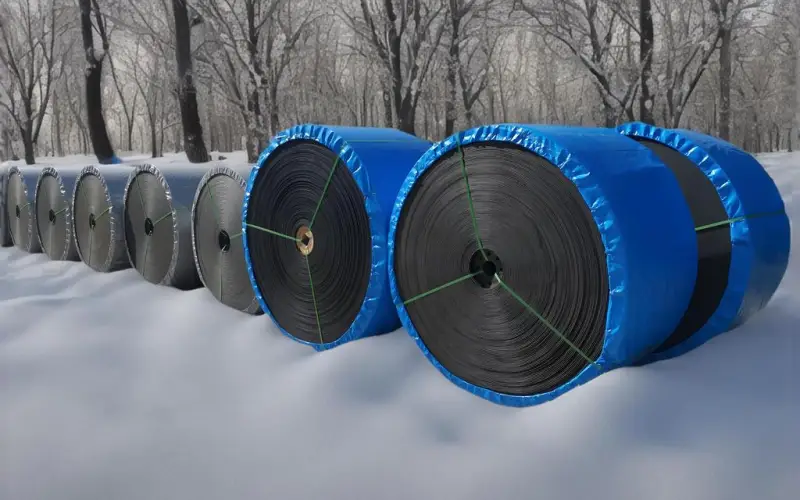
4.Abrasion-Resistant Rubber Conveyor Belt Material
In mining, quarrying, and aggregate transport, abrasion—not heat or cold—is the number one belt killer. When sharp rocks or heavy impact loads attack the cover, only the right rubber conveyor belt material can stand the test. Poor formulations wear out fast, leading to volume loss, spillage, and constant shutdowns.
4.1 Standards and Classifications
- DIN 22102: Defines Y, X, and W grades based on abrasion volume loss:
- Y≤150 mm³
- X≤120 mm³
- W≤90 mm³
- ISO 4649 / DIN 53516: Test method (rotating drum abrasion, volume loss in mm³).
- ARPM (ex-RMA, USA): Grade I and II, often referenced for cut and gouge resistance, though abrasion criteria differ slightly.
- DIN 22102: Defines Y, X, and W grades based on abrasion volume loss:
4.2 Polymer Systems and Formulations
Grade | Abrasion Requirement | Polymer System (phr) | Curing & Additives (phr) | Carbon Black (phr) | Applications |
DIN Y | ≤150 mm³ | SBR 40–60 + NR 40–60 | Sulfur 1.5–2.0; CBS/TBBS 0.6–1.0; antioxidants | 55–80 (N220/N330) | General mining, construction |
DIN X | ≤120 mm³ | NR 60–80 + SBR 20–40 | Sulfur 1.5–1.8; TBBS 0.6–1.0; stabilizers | 60–85 (N220/N330) | Heavy impact, quarry |
DIN W | ≤90 mm³ | High NR/SBR blend | Sulfur 1.4–1.8 + anti-reversion system | 70–90 (N220 high-structure) | Extreme abrasion (ore, sharp rock) |
Mechanism: NR provides high tensile strength and tear resistance, while high-structure carbon black (N220/N330) reinforces the matrix, lowering volume loss.
4.3 Tiantie’s Abrasion-Resistant Belts
According to Tiantie’s catalog, our abrasion-resistant conveyor belts are formulated to DIN Y/X/W standards, ensuring durability even under high-impact loads.
- Features: high-strength NR-rich covers, reinforced carcass for impact absorption.
- Applications: sand and gravel plants, mining conveyors, crushers, and impact loading systems.
- Performance: volume loss ≤90 mm³ for W grade, meeting international abrasion benchmarks.
4.4 Testing and Verification
Purpose | Method | Criteria |
Abrasion resistance | ISO 4649 rotating drum test | ≤150/120/90 mm³ depending on grade |
Impact resistance | Drop weight test | No cover cracking under repeated impact |
Field performance | Quarry trial | Belt lifetime ≥ specified tonnage before replacement |
4.5 Process and Failure Modes
- Process influence: dispersion of carbon black and vulcanization density strongly affect abrasion.
- Failure modes: excessive wear (volume loss > standard), surface cuts, or carcass exposure.
- Countermeasures: NR-rich formulations, anti-reversion agents, optimized curing cycles.
4.6 Lifetime and Maintenance
- Inspection: check belt thickness every 3 months in high-abrasion conveyors.
- Predictive wear mapping: measure volume loss zones near loading points.
- Maintenance tip: use chute liners and proper material flow control to extend belt life.
With the right balance of NR strength and abrasion-grade carbon black, Tiantie’s belts tested to DIN Y/X/W deliver the durability that mining and quarrying demand.

5.Flame-Resistant Rubber Conveyor Belt Material
In coal mines, power plants, and tunnels, fire risk is the most critical hazard. A single spark can ignite dust or gases, so belts must not only resist burning but also prevent static buildup. This is where flame-resistant rubber conveyor belt material plays its role—formulated to self-extinguish, minimize smoke, and protect workers and equipment.
5.1 Standards and Requirements
- ISO 340: Lab-scale flame test, ensuring belts self-extinguish.
- EN 12882 (surface use): Fire safety classes, including Class 2A (with covers) and 2B (with or without covers), plus ISO 284 antistatic requirement.
- EN 14973 (underground use): Stricter categories A, B1, B2, C1, C2 for underground mines.
- MSHA Part 14 (USA): Federal approval for underground flame-resistant belts.
- ISO 284: Requires electrical resistance ≤ 3 × 10⁸ Ω for antistatic safety.
5.2 Polymer Systems and Formulations
Type | Polymer System (phr) | Flame Retardant System (phr) | Carbon Black / Filler (phr) | Curing & Additives | Features |
Halogen-based | SBR/NR or with CR | Chlorinated paraffin 5–20 + Sb₂O₃ 3–10; ATH/MDH 20–60 | Conductive carbon black 10–30 + general black 20–40 | Sulfur 1.2–1.8; accelerators | High flame resistance; smoke/toxicity need control |
Halogen-free (low-smoke) | SBR/NR/EPDM | ATH/MDH 40–80 + P/N intumescent system (APP, MEL, PER) 15–40 | Conductive carbon black 10–25 | System-specific | Low smoke, eco-friendly; slightly lower abrasion |
Mechanism: CR or halogen structures release HCl to quench flame; ATH/MDH absorb heat; intumescent systems form an insulating char layer.
5.3 Tiantie’s Flame-Resistant Belts
Our catalog specifies flame-resistant conveyor belts that comply with ISO 340 and ISO 284. These belts:
- Use optimized rubber blends with flame retardants.
- Self-extinguish when exposed to fire, producing low smoke and low toxicity.
- Provide reliable antistatic properties for explosive environments.
- Applications include coal mines, power plants, and tunnel projects.
5.4 Testing and Verification
Purpose | Method | Criteria |
Flame resistance | ISO 340 vertical flame test | Self-extinguish within defined time |
Antistatic | ISO 284 | ≤ 3 × 10⁸ Ω |
Underground compliance | EN 14973 / MSHA Part 14 | Category-specific flame tests, roller friction, propagation |
5.5 Process and Failure Modes
- Process influence: Flame retardants must be well dispersed; poor mixing reduces effectiveness.
- Failure modes: Persistent burning, smoke excess, static discharge.
- Countermeasures: Correct halogen/ATH dosage, conductive fillers, and careful compounding balance.
5.6 Lifetime and Maintenance
- Regularly check electrical resistance for antistatic function.
- Inspect for cracks or cover damage that could expose carcass and compromise flame retardancy.
- Replace belts after fire exposure, even if damage looks minor.
Tiantie’s flame-resistant belts combine international safety standards with proven formulations, providing reliable protection in coal mines, tunnels, and power stations where safety cannot be compromised.
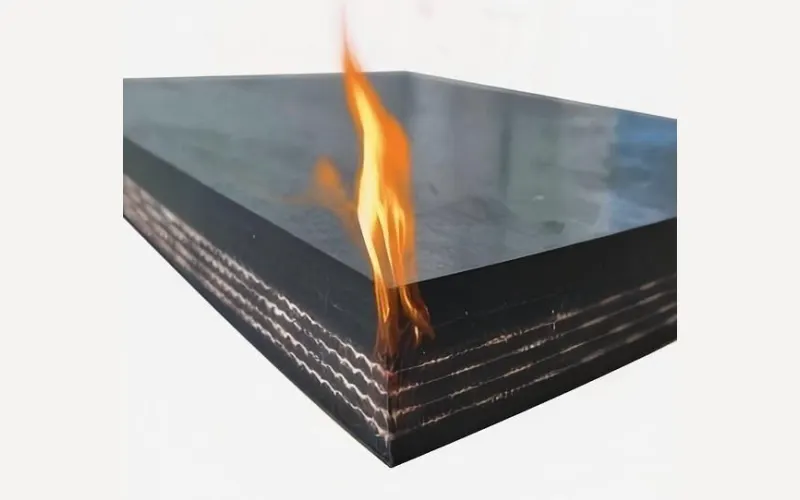
6.Oil-Resistant Rubber Conveyor Belt Material
When handling soybeans, rapeseed, chemical feedstock, or oil-bearing ores, ordinary belts swell, soften, and lose strength. Oils penetrate the cover, causing excessive volume expansion and even delamination. That’s why the right oil-resistant rubber conveyor belt material is essential for food processing, chemical transport, and mineral applications.
6.1 Standards and Requirements
- ISO 1817 / ASTM D1460: Evaluates volume change, hardness, and tensile loss after immersion in specified oils (e.g., IRM903).
- ARPM (ex-RMA) Grades:
- MOR (Moderate Oil Resistant): For vegetable oils, light petroleum.
- SOR (Superior Oil Resistant): For heavy petroleum, diesel, strong chemical oils.
- DIN 22102 G: Indicates oil resistance, but without specific numeric limits.
6.2 Polymer Systems and Formulations
Grade | Polymer System (phr) | Curing & Additives (phr) | Carbon Black (phr) | Features | Applications |
MOR | NBR (30–36% ACN) 60–100 + optional SBR | Sulfur 1.0–1.5; TBBS/CBS 0.6–1.0; antioxidants | 30–50 (N550/N772) | Balanced oil resistance and abrasion | Soybeans, grains, light oils |
SOR | High ACN NBR (36–45%) 80–100 or NBR/PVC 60/40–80/20 | Sulfur or peroxide depending on system | 25–45 (N772/N990) | Superior oil resistance, low volume swell | Heavy petroleum, diesel, chemical oils |
Mechanism: NBR resists oil penetration due to polar acrylonitrile groups. Higher ACN improves resistance but reduces low-temperature flexibility.
6.3 Tiantie’s Oil-Resistant Belts
Tiantie’s catalog includes oil-resistant conveyor belts that resist swelling and deformation even after long-term exposure to oils.
- Performance: Stable volume and tensile properties in oily conditions.
- Applications: Grain handling (soy, rapeseed), chemical plants, and oily mineral transport.
- Design: Reinforced carcass prevents delamination even when exposed to penetrating oils.
6.4 Testing and Verification
Purpose | Method | Criteria |
Oil immersion | ISO 1817 / ASTM D1460 | Volume change within MOR/SOR limits |
Strength retention | After immersion | Tensile loss ≤ 30% |
Field trials | Long-term oil contact | No excessive swelling or adhesion failure |
6.5 Process and Failure Modes
- Process sensitivity: High-ACN NBR compounds are harder to process; dispersion and mixing are critical.
- Failure modes: Volume swelling, softening, adhesion loss.
- Countermeasures: Use low-volatility oils, optimize cure density, balance ACN content for performance vs. flexibility.
6.6 Lifetime and Maintenance
- Avoid prolonged exposure beyond design oil type (vegetable vs. petroleum).
- Monitor belt thickness and hardness in contact zones.
- Schedule replacement if swelling >10% or adhesion weakens.
We’ve seen ordinary belts swell like sponges after just weeks in soybean or diesel service. With our oil-resistant compounds, the belt stays in shape, keeps its grip, and saves customers from the mess of constant replacements.
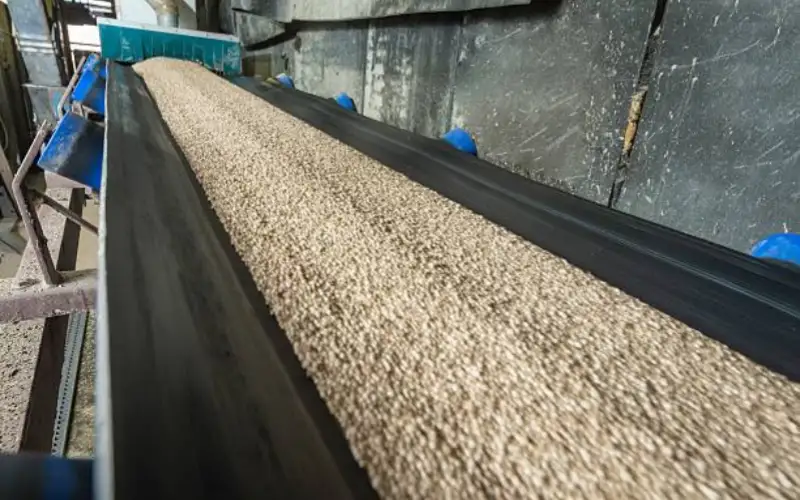
7.Acid- and Alkali-Resistant Rubber Conveyor Belt Material
Chemical plants, fertilizer factories, and electroplating workshops are some of the toughest environments for a conveyor belt. Acid and alkali exposure attacks rubber at the molecular level, breaking bonds and leading to rapid degradation. Only carefully selected rubber conveyor belt material can resist such environments and provide safe, stable transport.
7.1 Standards and Requirements
- ISO 1817: Standard immersion tests to measure volume change, hardness, and tensile variation in chemicals.
- GB/T 7984 Class C1 / C2: Chinese standard often applied in phosphate and chemical plants.
- Engineering practice: Belts are graded based on actual resistance to weak acids/alkalis or strong oxidizers, since no single universal standard covers all chemistries.
7.2 Polymer Systems and Formulations
Class | Polymer System (phr) | Curing & Additives (phr) | Carbon Black / Filler (phr) | Features | Applications |
C1 (mild acid/alkali) | EPDM 70–100 | Peroxide 1.5–2.5 + Co-agent 3–6; antioxidants | 30–55 (N772/N990, partial white fillers) | Stable in weak acid/alkali, ozone resistant | Fertilizer plants, chemical lines |
C2 (strong acid/alkali) | FKM (fluoroelastomer) 60–100 or CR/EPDM blend | Peroxide system; stabilizers | Chemical-resistant fillers | Excellent chemical resistance, high cost | Electroplating, strong chemical plants |
Specialty | CSM or advanced fluoroelastomer | Tailored curing | Inert fillers | Extreme resistance, limited use | Harsh oxidizing environments |
Mechanism: EPDM resists non-polar attack, FKM’s fluorine backbone prevents chemical reaction, while CR provides balance between cost and resistance.
7.3 Tiantie’s Acid/Alkali-Resistant Belts
Tiantie’s catalog specifies acid- and alkali-resistant conveyor belts designed for chemical and fertilizer industries.
- Performance: Stable properties in weak to moderate chemical exposure.
- Design: Rubber cover tailored with EPDM-based compounds for long life.
- Applications: Phosphate fertilizer transport, chemical powder lines, and electroplating environments.
7.4 Testing and Verification
Purpose | Method | Criteria |
Chemical resistance | ISO 1817 immersion | Volume change ≤ agreed % |
Tensile retention | Post-immersion | Strength loss ≤ 30% |
Field verification | Fertilizer/chemical plant trials | Service cycle ≥ standard belt lifetime |
7.5 Process and Failure Modes
- Process factors: Peroxide curing must be carefully balanced—under-curing reduces chemical resistance, over-curing reduces flexibility.
- Failure modes: Surface swelling, softening, and cracking from prolonged chemical attack.
- Countermeasures: Select correct polymer system for expected pH and chemical type; reinforce with chemical-stable fillers.
7.6 Lifetime and Maintenance
- Inspect belts regularly for swelling or surface cracking.
- Store spare belts away from chemical vapors.
- Replace early if cover softness increases noticeably.
Chemicals never forgive mistakes in material choice. With EPDM- and FKM-based compounds, Tiantie belts keep running where standard covers fail, giving operators one less thing to worry about in already demanding environments.
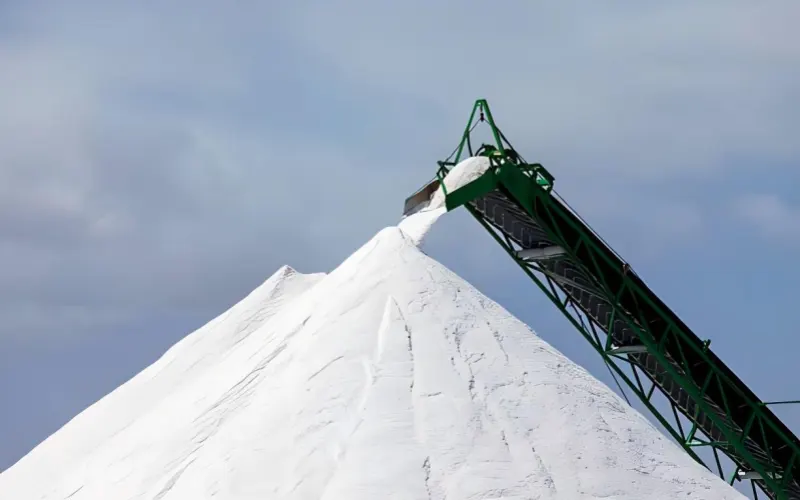
8.Comparative Overview & Selection Guide
Selecting the right rubber conveyor belt material is never a one-size-fits-all decision. Heat, cold, abrasion, flame, oil, or chemicals—each operating environment demands a different compound strategy. Below is a consolidated comparison of the six main categories.
8.1 Material Comparison Table
Belt Type | Standard Reference | Continuous Temp / Key Test | Polymer System (phr) | Main Additives | Applications |
ISO 4195, IS 1891-2 | T1 ≤100 °C; T4 ≤200 °C; peaks ≤300–400 °C | NR/SBR blends (T1–T2); High EPDM (T3–T4) | Sulfur or Peroxide + Antioxidants | Cement, steel, coke plants | |
Cold-Resistant | ISO 812, ASTM D2137 | −20 °C / −40 °C / −60 °C | BR 50–70 + NR 30–50 | Sulfur low-dose, wax, plasticizer | Arctic mines, ports, logistics |
Abrasion-Resistant | DIN 22102 Y/X/W | ≤150 / ≤120 / ≤90 mm³ abrasion loss | NR 60–80 + SBR 20–40 | Sulfur 1.5–2.0, antioxidants | Mining, quarries, aggregates |
Flame-Resistant | ISO 340, EN 12882, EN 14973, MSHA Part 14 | Self-extinguish + Antistatic (ISO 284) | SBR/NR with CR; EPDM for halogen-free | Halogen/Sb₂O₃ or ATH/MDH + conductive black | Coal mines, tunnels, power plants |
ISO 1817, ASTM D1460, ARPM MOR/SOR | Swelling resistance | NBR (30–45% ACN) or NBR/PVC blends | Sulfur or Peroxide + stabilizers | Grain, petroleum, chemical handling | |
Acid/Alkali-Resistant | ISO 1817, GB/T 7984 C1/C2 | Chemical immersion stability | EPDM 70–100; FKM/CR for strong acids | Peroxide + stabilizers | Fertilizer, chemical plants, plating |
8.2 Practical Selection Guidance
- High temperatures→ EPDM-based, peroxide cured (T3/T4).
- Extreme cold→ BR/NR blends with low sulfur, flexible even at −50 °C.
- Severe abrasion→ NR-rich with high-structure carbon black (DIN W).
- Flame risk→ CR/SBR halogen systems or halogen-free ATH/MDH for low smoke.
- Oily materials→ High-ACN NBR or NBR/PVC blends.
- Acid/alkali exposure→ EPDM for mild, FKM/CR for strong corrosive conditions.
8.3 Tiantie’s Advantage in Selection
Our catalog already groups belts into these categories, each designed to comply with international standards while fine-tuned for real operating conditions. This means that instead of adapting your process to a generic belt, you can select a Tiantie solution that matches your exact environment—whether it’s clinker at 180 °C, frozen coal at −40 °C, or corrosive phosphate dust.
When it comes to conveyor performance, the smartest choice is not the strongest belt on paper, but the one with the right Conveyor belt Rubber material tailored for your application. That’s where Tiantie ensures reliability across industries and climates.
9.Where Reliability Begins
Every conveying system is only as reliable as the material used on its belt surface. From blazing furnaces to frozen ports, from sharp ores to chemical dust, the choice of rubber conveyor belt material defines service life, safety, and cost efficiency.
At Tiantie, we’ve built our product line around these realities—heat-resistant, cold-resistant, abrasion-resistant, flame-resistant, oil-resistant, and chemical-resistant solutions, each aligned with global standards and proven in demanding industries. For customers, this means fewer breakdowns, longer lifespans, and belts that truly match the environment they work in.

